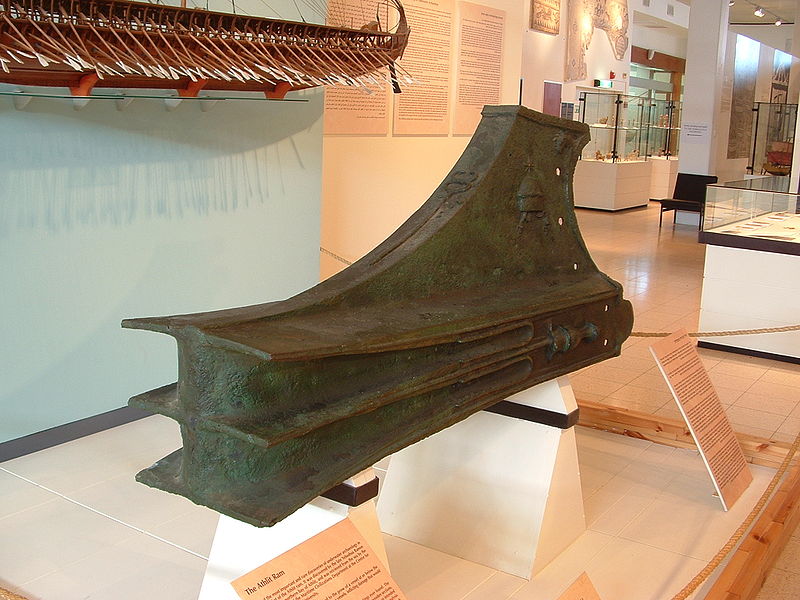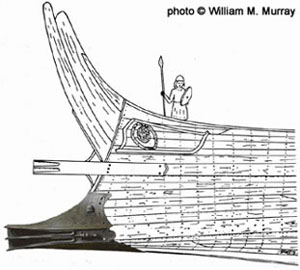
The discovery of a warship ram in the Mediterrean confirms the site as a major battle in 241 BC, in which Rome defeated its rival Carthage. The two powers were fighting for dominance of the Mediterrean Sea in a series of conflicts known as the Punic Wars.
Archaeologists think the newly discovered remnants of a war galley date from the final battle of the First Punic War, which allowed Rome to expand her dominance into the Western Mediterrean Sea.
The ram was found near the island of Levanzo west of the island of Sicily. The ram is all that remains of the galley, the rest, made of wood, has long since disintegrated.
This ram is the third discovery. In 2008, in the same gereral area, another beat up ram, with bits of wood still attached, enabled scientists to carbon date the object to the Punic Wars era.
Three years earlier, fishermen netted a ram which bore Latin insctiptions and covered with rosette designs. This certainly identified this ram as Roman in origin. By contrast, the two other rams were plain with no decorations and roughly cast. This indicated that the rams were hastely made, which fits with the historical accounts of the Carthaginean rush to gather a galley fleet in haste to meet the oncomming Roman agression.

In November 1980,in the Eastern Mediterrean shallows, near the historic town of Athlit, Israel, a bronze ram was recovered from the sea, with timber fragments attached to the metal. This was the first ancient ram ever discovered providing the evidence of an offensive weapon known only through literary references.


Coin of the Egyptian Pharaoh, Ptolemy V, Epihanes. Reverse, the imperial Ptolemic eagle.
The Athlit ram, now on display at the Israeli National Maritime Museum at Haifa, Israel is quite certain to have been cast in Egypt during the reign of Egyptian Pharaoh, Ptolemy V, Epihanes, or his successor, Ptolemy VI, Philometer. An eagle image cast onto the weapon identified the origine of the ram. Both of these rulers used the eagle symbol as a logo of their rule.
At the end of the third century BC, the Eastern Mediterrean was in a constant state of war over territorial disputes between the descendants of the two generals of Alexander the Great, the Ptolemic rulers of Egypt and the Seleucids dynasty of Syria . When Ptolemy V, Ephihanes became pharaoh at the tender age of six, with his mother, Arsinoe, as co-regent, conspirators assinated Arsinoe, throwing Egypt into political turmoil. Taking advantage of the upheaval, the Seleucide ruler of Syria, Antiochus III, annexed Egyptian territory including Judea, modern Israel, defeating the Ptolemic Egyptian army at Panium. A truce was declaired before Ptolemy V died in 181 BC. War resumed in 175 BC when Ptolemy V's successor, Ptolemy VI, Philometor had to flee to Rome, when Syrian monarch, Antiochus IV, invaded Egypt, then was driven out when Ptolemy VI returned with a mercenary army. Somewhere in these events, the Athlit ram became a casualty of war.

The athlit ram was probably made in a single casting process by the lost wax method, in which a wax model is made, then encased in a clay mold. Molten bronze is then poured through channels into the clay mold, and at the same time, melting the wax, which pours out of another channel. When the bronze is cooled, the clay mold is broken to reveal a replica of the wax model which included the eagle logo of Ptolemic rule. It is not known if the ram was attached to a bireme, a galley propelled by two banks of oars, or a trireme, a vessel propelled by three banks of oars.

What ever kind of oared powered vessel the Athlit ram was attached to, the ram represents the golden age of ancient galley warfare in the Mediterrean during the classical period. Both the Ptolemys and the Seleucids employed technological advanced weapon platforms on their galleys, including ballistas that rotated on a ballbearing mechanisms and hurled showers of projectiles and clay pots of incendiary materials. The battle of Actium, where the forces of Octavian defeated Mark Anthony, was the last of mass galley warefare, not to be repeated more than 1500 years later at Lepanto, scene of a European naval victory over the Turks on the Eastern Mediterrean.
Montani semper liberi ! Happy modeling to all and every one of you.
Crackers 